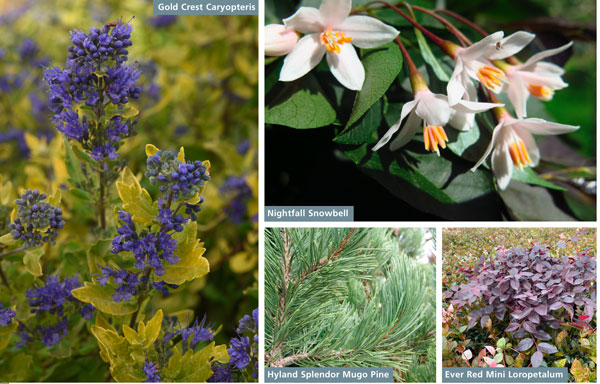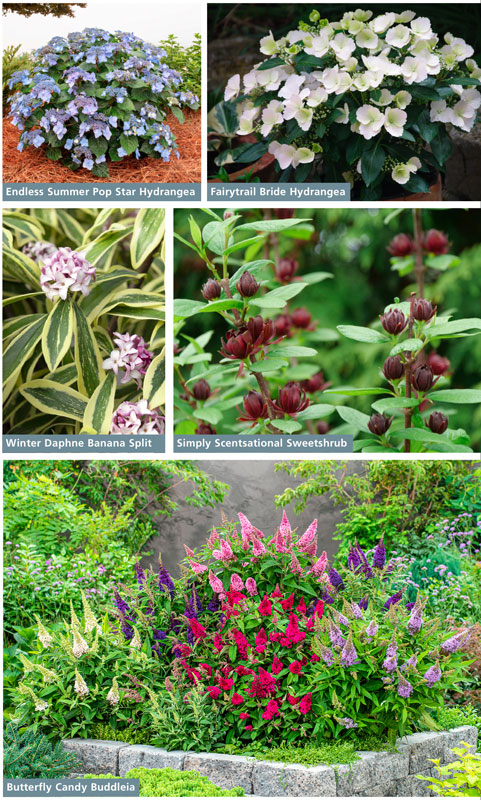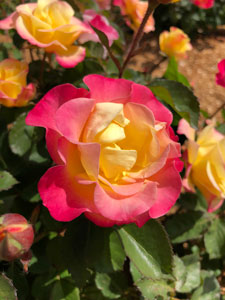8/1/2022
On Deck
Dr. Matthew Chappell
It’s that time of the year when we all look to what’s coming in the way of new genetics for the fall and next spring. This story will focus on new cultivars of note in the realm of woodies and sub-shrubs, of which there are A LOT to choose from.
After putting out a request to plant breeders and branding companies, over 150 new cultivars rolled into my inbox. But that certainly seems to be the trend, with greater numbers of new releases hitting the market annually. Personally, I always wonder how many new cultivars the market can accept, but then again, the cream seems to always rise to the top.
Following is a list of notable releases coming in Fall 2022 and Spring 2023 based upon uniqueness among other cultivars within the same taxa. But keep an eye on my Nursery & Landscape Insider newsletter, as there are certainly many cultivars not covered here that will be included in future newsletters. (You can sign up for it at growertalks.com/Newsletters.)
 Gold Crest Caryopteris (Caryopteris x clandonensis)
Gold Crest Caryopteris (Caryopteris x clandonensis)
It’s tough not to like caryopteris, considering its unique set of traits, most notably its fall-blooming cycle and rich blue flower color. Gold Crest from Darwin Perennials adds to this charm with golden foliage color during the growing season that takes on an orange hue in the fall. That additional spring/summer interest sets this cultivar apart in my book.
It’s also an easily maintained plant, with a 3-ft. mounding habit that doesn’t require any significant pruning to maintain a tidy appearance. Like most caryopteris cultivars, Gold Crest is hardy across Zones 6 to 9a, prefers evenly moist, well-drained, slightly acidic soils and can tolerate drier soils once established.
Another nice aspect of this cultivar is that it can be used as an accent plant for your butterfly garden, it makes a great foundational landscape choice and it stands out in a mixed container.
Nightfall Snowbell (Styrax japonicus)
A large deciduous shrub/small tree that, while not new (it hit the market earlier this year), will be available in numbers worthy of a wider introduction in spring of 2023. Nightfall Snowbell is an absolute breakthrough in that it combines the deep purple foliage of Evening Light Snowbell with the gracefully weeping form of green-leafed cultivars like Fragrant Fountain.
Zone 5 to 9a hardy, purple leaves emerge with green undertones and provide a lush, high-contrast backdrop for slender, pearly white, flower buds of late spring. These open to reveal creamy white, bell-shaped blooms. Offset by dark foliage, the flowers cascade from its weeping branches, just in time to ring in summer. Leaves darken as the season wears on, becoming deep purple by summer’s end. Bare branches etch a graceful waterfall in the winter landscape.
Vigorous and fast-growing, it reaches an ultimate size of 8 ft. in height with a 6-ft. spread and is suited to locations with consistent soil moisture and some afternoon shade (especially further south).
Hyland Splendor Mugo Pine (Pinus mugo)
Here’s to all of you wonderful and tough-as-nails folks in Zone 3, even though the species is hardy to a balmy Zone 7! From the breeding program of Dr. Todd West (the pride of North Dakota State University) and available via Oregon Pride Nursery, Hyland Splendor represents a significant improvement in the species, as it has darker green foliage and a faster growth rate as compared to the current industry standard Tannenbaum.
Hyland Splendor is also unique in that it doesn’t develop the typical yellow-green winter needle color and stays a superior dark green. In nursery trials, it’s grown 20% faster than Tannenbaum. As with most mugo pine cultivars, Hyland Splendor prefers full sun to part shade, reaches a mature size of 15 ft. in height and 8-ft. spread, and has an upright pyramidal habit. It’s remarkably drought tolerant when established and also tolerates heavy clay soils, as well as a wide range of soil pH (for those with alkalinity issues).
Ever Red Mini Loropetalum (Loropetalum chinense)
It wasn’t too long ago that a flood of new loropetalum cultivars were hitting the market. But with the exception of a few standouts, the general sentiment was that if you’ve seen one loropetalum, you’ve seen them all. And, quite frankly, how many ways can you combine green (a few with variegation) or burgundy foliage color with white, pink or red blooms, given most all cultivars reached a fairly massive size in the landscape? And the few cultivars that were truly smaller in stature were so because of genetically weak growth, making propagation and growing out in a container a supreme headache for growers.
But not all hope should be lost on smaller loropetalums for the landscape and Ever Red Mini (Gardener’s Confidence Collection) seems to be on the right track. Coming in at about 4 ft. in height with a 6-ft. spread, it doesn’t suffer from the watersprout issues many loropetalum cultivars face. It has extremely dark, burgundy foliage that keeps its color throughout summer with red blooms to boot in early spring. Otherwise, treat it like any other loropetalums, which seem to admire complete neglect in the landscape as long as you’re in Zones 7 to 9.
 Endless Summer Pop Star Hydrangea (Hydrangea macrophylla)
Endless Summer Pop Star Hydrangea (Hydrangea macrophylla)
You knew at least one hydrangea would make the list, right? After all, the taxa continues to stake out a huge market share (and rightfully so). Endless Summer Pop Star (Bailey) continues the tradition of refinement of this species by the brand that started it all in remontant flowering hydrangea. Pop Star rocks on as a genetically compact (3-ft. rounded) and incredibly floriferous lacecap variety that’s a standout in the landscape or decorative container. It has strong bud hardiness (Zone 4), reliable rebloom and doesn’t need pruning to keep its size. Dark green leaves with blue (acidic soils) or pink (neutral to basic soils) blooms provide year-after-year color and interest.
As with pretty much all Hydrangea macrophylla, it can do full sun in the great north, but the farther south you go a bit more afternoon shade and supplemental irrigation will be needed to maintain summer vigor.
Fairytrail Bride Hydrangea (Hydrangea hybrid)
This one may not be new globally, but it’s certainly new to North America. Proven Winners has imported the legendary Cascade Hydrangea that won Plant of the Year at the Chelsea Flower Show in 2018. Long, trailing stems draped in white lace with a bouquet of florets at every leaf node yields a dramatic display. It also creates new uses for all kinds of spaces, such as hanging baskets/cascading containers, and spilling over rocks and wall spaces.
But note that the hardiness on this cultivar is only Zones 6 to 9, so winter hardiness may be an issue if you’re used to hydrangeas in Zone 4. Treat it as you would a Hydrangea macrophylla with regard to cultural conditions and expect a mature height of 3 ft. and 4-ft. spread in the landscape.
Winter Daphne Banana Split (Daphne odora)
People always think I’m partially to mostly crazy when I tell them that daphne is one of the toughest plants you can put in a garden, but it is. In fact, most are killed by those who love them to death via irrigation. So keep them dry, in afternoon shade and within Zones 7 to 9, and you’ll be delighted.
Now, what makes Banana Split (from Monrovia) unique is the foliage, which is rather beautiful. Each of the leaves features a wide, bright yellow edge that highlights the sweetly fragrant blooms. The buds start out a rosy pink and open to a beautiful white. As with most daphne, this cultivar reaches a mature size of about 4-ft. tall with a similar spread.
Simply Scentsational Sweetshrub (Calycanthus floridus)
Finally, a North American Native (Zones 4 to 9) with some seriously awesome traits! Kudos to Proven Winners on this introduction. Simply Scentsational Sweetshrub combines a few nice attributes into a mainstream-worthy nativar.
First, when you approach this plant, your nose knows. It’s the sweetshrub that actually lives up to, and maybe even exceeds, the oft-described (but seldom smelled) hints of pineapple and bubblegum fragrance.
Selected and refined over an 18-year period by Spring Meadow’s Tim Wood, the blooms are an intriguing deep maroon and appear in abundance through late spring and summer—not just a quick burst in mid-spring. As with most Calycanthus floridus, expect a 6-ft. tall plant with a 5-ft. spread and a bit of suckering. Place it in an area with consistent soil moisture and afternoon shade (especially down south) and you won’t be disappointed.
Butterfly Candy Buddleia (Buddleja hybrid)
Buddleia may be an issue in certain regions of North America with regard to invasive potential, but that doesn’t mean it’s not worthy of praise for a majority of us. Southern Living Plant Collection (PDSI) has introduced a series of new cultivars that bring a splash of color to the landscape and offer a sweet treat to pollinators. The Butterfly Candy series offers five bright hues for the garden, including Lil’ Coconut, Lil’ Bubblegum, Lil’ Raspberry, Lil’ Lavender and Lil’ Grape.
This series has a very uniform growth habit (2- to 3-ft. rounded habit) among the cultivars, which presents very well in the landscape as a mass planting. As with most buddleia, all are easy to care for in the full sun landscape, and they rebloom all spring and summer, attracting butterflies and pollinators to the landscape all season long. And they’ll be perennial for many, having a range of Zones 5 to 10, but could be used as annuals elsewhere.
 Gumball Machine Rose (Rosa hybrid)
Gumball Machine Rose (Rosa hybrid)
A new genetics article wouldn’t be complete without a rose, and a rose isn’t a rose these days unless it can provide something other than a pink, white, yellow or red bloom. So why not have a new introduction with red, yellow AND pink fragrant double flowers on the same plant to dazzle the senses from late spring to frost?
That’s what you get from this Bloomin’ Easy introduction hardy in Zones 3 to 9. Extreme winter hardiness (for a rose) and resistance to foliar disease allows it to be enjoyed across all regions of North America without excessive inputs. And its natural gumball shape (3-ft. height and 2-ft. spread) keeps it small and tidy in smaller spaces or makes it adaptable to containers. Otherwise, treat it like a rose and it’ll be happy as a … rose. GT
Matthew Chappell is a Professor of Plant & Environmental Sciences, Director at the Virginia Tech—Tidewater Agricultural Research & Extension Center, and editor of our Nursery & Landscape Insider e-newsletter.